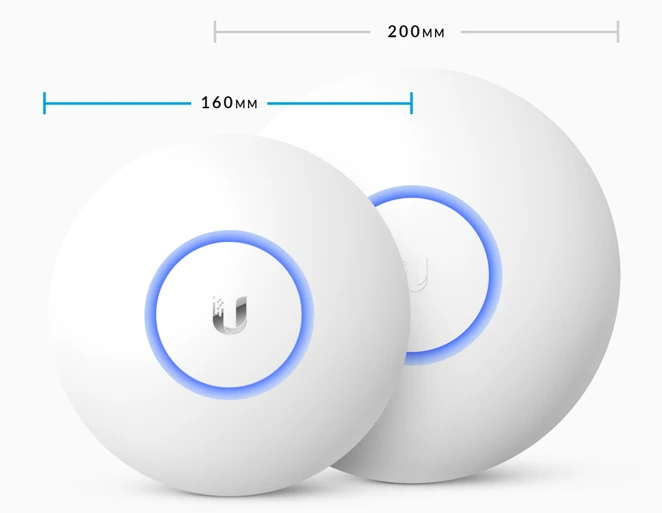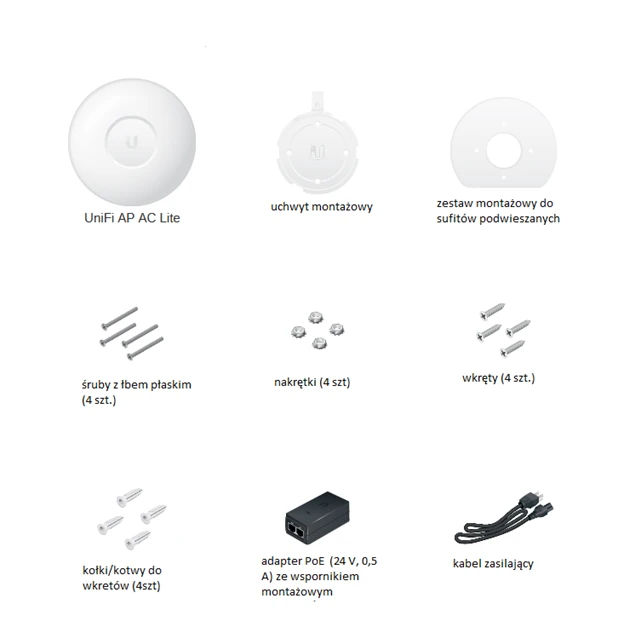The compact UAP-AC-LITE from Ubiquiti is a proposal that provides WiFi 5 - 802.11ac wireless connectivity for home or business at an affordable price. Sleek, minimalist design, a consistent management system and good performance - these are the features that stand out among a number of others for the tested access point from Ubiquiti. The equipment is about 25% smaller than other devices of this type from the UniFi series. It is based on 2x2 MIMO technology, with 24V Passive PoE capability and a WiFi range of up to 122 meters. The total maximum throughput is 300 Mbps for 2.4 GHz and 867 Mbps for the 5 GHz band. How does the device perform in tests and what possibilities does it provide? We have checked that in test conditions similar to others so that we can compare the results.
Device specifications Ubiquiti UAP-AC-LITE
Ubiquiti Access Point AC-Lite is designed for indoor use. It is a dual-band device, operating in the
IEEE 802.11ac standard, and is, of course, backward compatible with other standards. Thanks to the MIMO 2x2 antennas, the maximum throughput is determined at the total level of 1000 Mbps, with theoretical maximum of 300 Mbps in the 2.4 GHz band and 867 Mbps in the 5 GHz band. The Dual-Band 3 dBi three-pole antenna provides a maximum Tx transmit power of 20 dBm, the same for both frequencies. The network device has
one RJ-45 LAN port in the Gigabit Ethernet standard, also providing 24V Passive PoE. The manufacturer provides the possibility of mounting the device on the ceiling or wall, thanks to the included accessories. The design of the UAP-AC-LITE, characteristic for the
Ubiquiti UniFi line of products, allows to match the equipment to almost any interior decor. Operation is possible in a wide range of relative humidity 5-95 and temperatures -10 to 70 degrees Celsius.
Physically the access point lite from Ubiquiti has a diameter of 160 mm, height 31.4 mm. It is currently the smallest physical solution from UniFi. Its weight is only 170 grams, or 185 grams with the mounting kit. It comes in a white color, with a clearly visible and elegant manufacturer's logo and a blue illuminated circle. It's minimalist design fits into any interior. On the bottom it has a physical reset button and a LAN port, as well as a cable entry and locking elements for the mounting kit, making it easy to hang on the wall or ceiling. The power supply of the device is 24V, 0.5A, 1 Gigabit Passive PoE adapter, the maximum power consumption is specified at 6.5W.
Unboxing UniFi Access Point AC-LITE - Package contents
The elegant design of the UniFi Access Point is evident in the packaging already - small, simple and with a holographic mark confirming its genuinity. Inside you can find almost all components for mounting and setting up the device. There is both a wall or ceiling mounting kit and a suspended ceiling kit, including not only brackets but also screws, nuts and wall plugs. A PoE adapter along with a power cord provides the power supply.
The manufacturer also provides a brief description - instructions for operation, installation, and configuration. The set does not include a twisted-pair Ethernet cable, which is justified due to different possible mounting locations and the necessity of using cables of different lengths. UniFi Access Point AC-LITE is a business-class device, so it should be installed by a professional who should always have such accessories at his disposal.
Initial configuration for UniFi Access Point AC-LITE from Ubiquiti
Getting the UAP-AC-LITE from Ubiquiti up and running for the first time is extremely easy. After plugging the power supply in and connecting it with an Ethernet cable to the access point, the equipment allows configuration using the UniFi OS Console unified software. It can be incorporated into an existing network of devices, configured using the software, or connected to a device with a built-in UDM-Pro controller, as was done in our configuration. This way, after logging in with a newly connected device, the installation wizard runs itself and guides you through simple steps. First, a quick configuration of the UniFi Dream Machine Pro, using an existing or creating a new account on UI.com. We've also included a USW-Industrial switch and two UAP-AC-LITE access points in the topology, including one connected wirelessly as part of MESH.
Before installing the access points in the target location it is worthwhile to perform their initial configuration in close proximity to each other. This way, after the standard configuration of the first access point and starting the next one, the equipment will detect itself and just wait for adoption in the UniFi OS Console.
In the configuration regarding the tested WiFi network, for 2.4 GHz connections we assumed the maximum channel width to be 40 MHz, and for 5 GHz the channel width was 80 MHz. The Ubiquiti UAP AC Lite can operate in the 5 GHz band with a maximum channel width of up to 80 MHz.
Notes on management capabilities of UAP-AC-LITE
The process of running access points in the UniFi software went without any problems with detecting or adopting the devices. The fact that every change of the radio settings, be it for 5 GHz or only for 2.4 GHz, forced another DFS Waiting message and waiting for service startup was an inconvenience. The equipment allows to configure operation in various modes, which allows for flexible and intuitive creation of home and business networks. It has many built-in mechanisms to optimize clients' wireless connections that require no additional settings. Advanced traffic management capabilities include 802.1Q VLAN support , QoS,guest traffic isolation, WMM. The equipment can support up to 250 clients.
UAP-AC-LITE access point test - conditions
The test conditions of the UAP-AC-LITE device are based on similar network topology and distribution of devices and test points as in our other WiFi wireless device tests. They can also be easily compared with the tests of other equipment from UniFi line - UAP-AC-LR. The created network looks as follows:
The goal of the tests was to verify mesh network coverage and available throughput in fixed points of the premises - signal coverage and real speeds. Speed tests were performed using WiFiPerf software, and the speed test server was iperf3 software. The test device was a MacBook Pro A1502 equipped with a built-in AirPort Extreme wireless network card - Broadcom BCM4360 3x3, 1.3 Gbps PHY, running on IEEE 802.11a/b/g/n/ac standards, compatible with WiFi 5, and a 10/100/1000 Mbps Gigabit Ethernet card. Before we started WiFi testing, we verified the actual performance of the Gigabit LAN and the iperf3 server. We obtained the following maximum speeds for a single TCP stream: download 894 Mbps, upload 958 Mbps.
How did the dual-band AC-lite access point from Ubiquiti stand up to the test?
We tested the access points in a two-story building with a basement, with thick ceilings and many solid walls. One of the UAP-AC-LITE access points was placed directly on the ground floor and connected with a cable to a gigabit switch, and the second floor above, establishing a wireless connection with the first AP. We used AirSurvey software to perform a signal map. Coverage is average, but expected with this arrangement of devices.
Apart from that, we tested the performance of the UniFi Access Point Lite with a radio spectrum analyzer. The results clearly show that the channel width is slightly narrower than its available range, it does not overlap with the adjacent ones, so the UniFi Access Point Lite performs easily with multiple transmitting devices.
The throughput test results were average, but we have to admit that they are quite stable.
At each of the test points it was possible to get a connection.
The first test point allowed an average download speed of 439 Mbps, with periodic spikes up to 500 Mbps. Sending followed a similar pattern for about half the time, only to drop to 311-335 Mbps later, giving an average result of 387 Mbps. The second measurement site
achieved very similar results for download, averaging 437 Mbps and 371 Mbps upload, with uploads being more stable.
The third point clearly shows the impact of obstacles in the signal's path, as the average S/R Bandwidth download was 375 Mbps and upload was 200. The next point further shows the weakening of coverage, giving results at an average of 267 Mbps / 91 Mbps. The fifth and sixth measurement points gave mediocre results of 21-60 Mbps download and 15-28 Mbps upload, but it is worth noting that the connection was still stable.
Measurement point 1 - Download 515 Mbps / Upload 490 Mbps
Measurement point 2 - Download 488 Mbps / Upload 401 Mbps
Measurement point 3 - Download 413 Mbps / Upload 258 Mbps
Measurement point 4 - Download 323 Mbps / Upload 131 Mbps
Measurement point 5 - Download 24 Mbps / Upload 17 Mbps
Measurement point 6 - Download 74 Mbps / Upload 38 Mbps
At the fifth measurement point, the connection was established with a device on the first floor, which operated in MESH mode, i.e. the signal was retransmitted by the upper access point. In our opinion, the measurement in all rooms on the first floor was limited by the low performance of the mesh network connection. Despite short mounting distance of about 5 m between the APs, they were separated by a thick load-bearing wall and about 25 cm thick ceiling, additionally placed at a sharp angle which realistically increased the thickness of the obstruction.
Elegant AP for basic applications - summary
There is no denying that the Lite version of the access point from the line of UniFi devices shows the weakest performance. The characteristics of the built-in antenna do not ensure fully uniform radiation in all directions, and the metal brackets used affect the formation of the radio beam. It creates then a screen narrowing the radio beam and increasing the radiated power. Still, it is a powerful device, not too expensive compared to other UniFi AP models, compact and easy to manage, consistent with the existing UniFi OS Console system. It will perform well in numerous applications, and the implemented functionality in the minimalist hardware is fully sufficient in many cases. Quickly attaching to existing UniFi topologies, networks created with the UAP-AC-LITE scale perfectly. Therefore, if your location does not place much emphasis on the highest wireless performance and you need a convenient, basic solution with a range of business capabilities, the Ubiquiti UniFi Access Point AC Lite will be an ideal proposition.
 Click to enlarge!
Click to enlarge!
 Click to enlarge!
Click to enlarge!
 Click to enlarge!
Click to enlarge!
 Click to enlarge!
Click to enlarge!
 Click to enlarge!
Click to enlarge!
 Click to enlarge!
Click to enlarge!
 Click to enlarge!
Click to enlarge!
 Click to enlarge!
Click to enlarge!
 Click to enlarge!
Click to enlarge!
 Click to enlarge!
Click to enlarge!
 Click to enlarge!
Click to enlarge!
 Click to enlarge!
Click to enlarge!
 Click to enlarge!
Click to enlarge!
 Click to enlarge!
Click to enlarge!
 Click to enlarge!
Click to enlarge!
 Click to enlarge!
Click to enlarge!
 Click to enlarge!
Click to enlarge!
 Click to enlarge!
Click to enlarge!
 Click to enlarge!
Click to enlarge!
 Click to enlarge!
Click to enlarge!